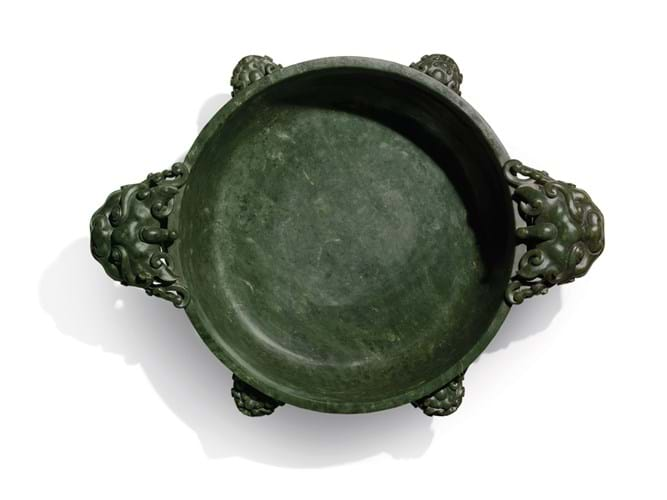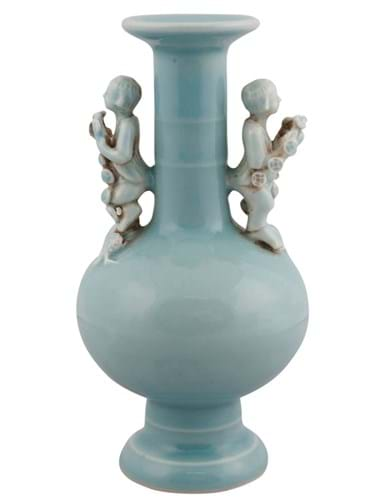Thirteen auction houses are taking part in this year’s Asian Art in London from November 1-10, the number swollen by overseas as well as UK regional salerooms.
Beyond the capital, a busy autumn calendar includes a number of specialist Asian auctions offering works across a wide price spectrum.
Here ATG selects 10 individual highlights on offer with estimates ranging from £400 to £800,000.
1. Sotheby’s – Jade washer
A Qianlong period spinach-green jade washer or marriage bowl, carved with a total of six beast-head handles and freely moving rings, is offered at Sotheby’s sale of Important Chinese Art on November 7. It is estimated at £600,000-800,000.
Once in the collection of Robert Napier, First Baron Napier of Magdala (1810-90), this monumental carving was among the 3080 works exhibited at The Royal Academy’s 1935 International Exhibition of Chinese Art.
Jades of this quality, size and even colour only became possible during 1760s after the Qing army exerted control over the mines and rivers in the Khotan region. According to palace documents of the period, jade washers with freely-moving rings typically came with two, four, or six rings – the latter the most challenging to carve in an era when jade was cut by hand on an iron mill.
2. Bonhams – Tang camel
A large and realistically modelled sancai-glazed statue of a braying beast, standing 2ft 8in (82cm) high, forms part of the Bonhams’ November 8 single-owner sale titled The Ollivier Collection of Early Chinese Art: A Journey Through Time. It is estimated at £300,000-400,000.
In the 9th century, Bactrian camels, imported from Turkestan and Mongolia, were essential for conducting trade with the oasis cities of Central Asia. The species was highly regarded by the Tang emperors, who established dedicated offices to oversee the imperial camel herds. This statue was undoubtedly made to be buried with an elite member of society.
The figure was acquired by the French businessman and philanthropist, Jean-Yves Ollivier, from a dealer in Hong Kong in November 1991.
3. Cheffins – Snake lamp
Han dynasty bronze lamps of the type offered at Cheffins of Cambridge on November 8 usually come in the form of goose feet. This example however is thought to be the only known surviving example styled as a snake. It is estimated at £80,000-120,000.
Snakes were known to have been important in the ancient Chu Kingdom, having been discovered on the 5th century tombs of Zeng Hou Yi in the Hubei province in central China (one of only a handful of ancient Chinese royal tombs to have been discovered intact).
The piece has been consigned from a Hong Kong collector.
4. Halls – Blue and white censer

A blue and white ‘flower and wave’ censer and cover made during the Ming dynasty – estimated at £30,000-50,000 at Halls.
Among the ceramic pieces to go under the hammer at Halls’ November 28 sale in Shrewsbury, Shropshire, is a blue and white ‘flower and wave’ censer and cover. With a six-character Xuande mark, it was made during the Ming dynasty for the Persian market.
It is estimated at £30,000-50,000.
5. Chiswick Auctions – Qianlong scroll
A calligraphic work by the Qianlong emperor (reigning 1735-96) will be offered at Chiswick Auctions’ sale of Fine Chinese Paintings on November 12. It is estimated to fetch £6000-8000.
The ink on paper hanging scroll of running script, measuring 5ft 2in x 21in (1.58m x 53cm), copies a poem by Wei Zhuang (836-910) which was included in the literary encyclopaedia Siku Quanshu (The Complete Library in Four Branches of Literature) commissioned by the Qianlong in 1772. It is signed Yu Bi or ‘From the Brush of His Majesty’.
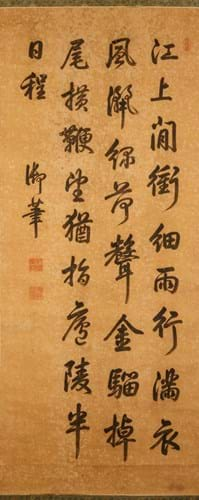
An ink on paper hanging scroll of running script by the Qianlong emperor – estimated at £6000-£8000 at Chiswick Auctions.
Born Hongli, the fourth son of the emperor Yongzheng, the Qianlong emperor (reigning 1735-96) was arguably the greatest collector and patron of the arts in more than 5000 years of Chinese history. His collection spanned Chinese, European, Japanese and Indian works of art and he was a prolific poet and calligrapher in his own right.
6. Roseberys – Yongzheng bottle
A Yongzheng mark and period ‘Liu Hai’ bottle in a claire de lune glaze is offered at Roseberys London on November 12. It is estimated at £10,000-15,000.
The 6½in (16cm) vase includes two figures of Liu Hai, a Song dynasty minister of state who was a student of Taoist magic. He is depicted with a three-legged toad, a mythical creature he would lure from a well with a line baited with gold coins. The scene is an emblem of good fortune.
The form and colour of glaze of this vase is particularly rare. A near-identical example with a white glaze can be seen in the Palace Museum, Beijing, while a pair with a white glaze were sold by Christie’s in Hong Kong in 2013. This example comes from a private London collection, acquired in the 1960s.
7. Woolley & Wallis – Cloisonné dish

A dish from the workshop of cloisonné artist Namikawa Yasuyuki – estimated at £3000-5000 at Woolley & Wallis.
The market for the best Meiji material is still dominated by brand names, with collectors “particularly interested in anything different”, says Woolley & Wallis Japanese works of art specialist Alexandra Aguilar Doméracki.
A dish from the workshop of cloisonné artist Namikawa Yasuyuki – a relatively late design from after 1903 with landscape decoration – carries an estimate of £3000-5000 in a specialist sale of Japanese & Korean Art in Salisbury on November 14.
8. Matthew Barton – Celadon lotus vase
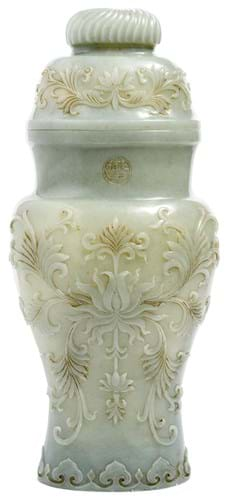
A Mughal-style greyish celadon jade ‘lotus’ vase – estimated at £3000-5000 at Matthew Barton’s sale.
A Swiss collection of mostly 18th century Chinese celadon jades inspired by those exported from Mughal territory in India forms part of Matthew Barton’s sale of European and Asian Works of Art, held on November 21 at 25 Blythe Road in West Kensington.
The group of more than 60 pieces features an array of sceptres, vases, fans, seals, court necklaces and snuff bottles ranging in price from £100-12,000. A Mughal-style greyish celadon jade ‘lotus’ vase is included in the sale. It is guided at £3000-5000.
9. Toovey’s – Export reverse mirror
With its vibrant colours and exotic flavour, Chinese export reverse glass painting was the height of fashionable sophistication in English country house collections in the 18th century.
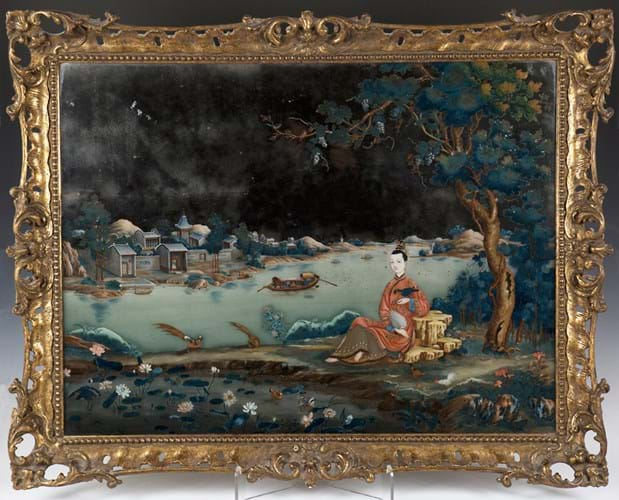
A Chinese export reverse mirror dating to the Qianlong period – estimated at £30,000-50,000 at Toovey’s.
A well-preserved Chinese export reverse mirror dating to the Qianlong period and decorated with a lady seated on a rock beside a lotus pond is offered at Toovey’s sale in Washington, West Sussex, on November 29. It is estimated at £30,000-50,000.
Housed within a carved and pierced rococo scroll openwork giltwood frame, the work measures 23in x 2ft 6in (58 x 77.5cm).
10. Brightwells – Late Qing carving
With its extra silver embellishments, large size and subject matter, a 2ft 2in (65cm) high hardwood carving of Shoulao offered at Brightwells of Leominster on November 14-15 is unusual for the late Qing dynasty. It is estimated at £400-600.
The deity is depicted riding on the back of a deer – thought to be the only animal in China that can sniff out the highly-prized ‘lingzhi’ mushroom.
They are also symbolic of wealth as ‘lu’, the word for deer in Chinese, can also be translated as the salary of an official.




